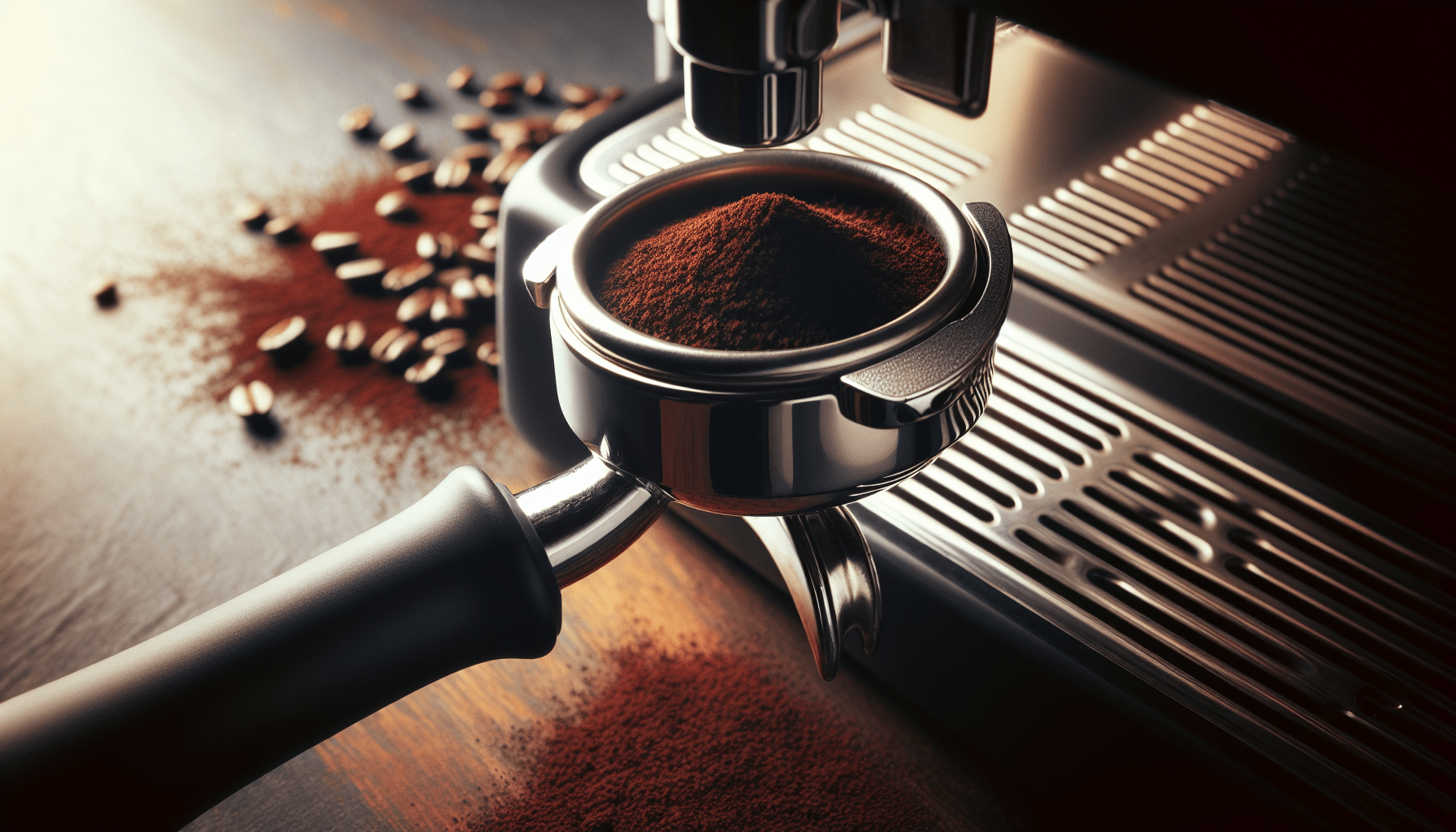Are you a coffee lover who wants to achieve that perfect velvety texture in your homemade lattes or cappuccinos? Well, good news! With a semi-automatic espresso machine, you can indeed steam milk to create deliciously frothy and creamy beverages right in the comfort of your own kitchen. Gone are the days of relying solely on your favorite coffee shop for that perfectly steamed milk. In this article, we will guide you through the process of steaming milk using a semi-automatic espresso machine, ensuring that you achieve barista-quality results every time. So, grab your apron and let’s get steaming!
What is a semi-automatic espresso machine?
A semi-automatic espresso machine is a type of coffee machine that allows you to have more control over the brewing process compared to fully automatic machines. It combines the convenience of automated water temperature and pressure control with the hands-on approach of manually starting and stopping the extraction process. With a semi-automatic machine, you have the ability to adjust the brewing parameters according to your preferences and ensure the perfect espresso shot every time.
Definition
A semi-automatic espresso machine works by using a pump to push hot water through the ground coffee beans at a consistent pressure. This pressure helps to extract the rich flavors and aromas from the coffee, resulting in a concentrated and flavorful shot of espresso. The machine allows you to control the amount of water used, the grind size of the coffee, and the extraction time, giving you the flexibility to customize your espresso to your liking.
Features
Semi-automatic espresso machines come with a variety of features that enhance your coffee-making experience. These may include a built-in grinder, a steam wand for frothing milk, a PID (Proportional Integral Derivative) controller for precise temperature control, programmable buttons for shot volumes, and more. These features not only make the machine versatile but also ensure that you have the necessary tools to create café-quality lattes and cappuccinos at home.
Why steam milk with a semi-automatic espresso machine?
Steaming milk is an essential skill for creating delicious lattes and cappuccinos, and a semi-automatic espresso machine gives you the perfect platform to master this technique. Here are a few reasons why steaming milk with a semi-automatic machine is advantageous:
Consistency
With a semi-automatic espresso machine, you can achieve consistent results every time you steam milk. The ability to control the steam pressure and movement of the steam wand allows you to create a velvety texture and incorporate the perfect amount of microfoam in your milk. This consistency ensures that each cup of coffee you make has the same quality and taste, making it a treat for both yourself and your guests.
Control over temperature and texture
One of the key benefits of using a semi-automatic machine to steam milk is the control it gives you over the temperature and texture of the milk. Different coffee beverages require different milk temperatures and foam consistencies. With a semi-automatic machine, you have the freedom to adjust the steam wand’s position, steam pressure, and time to achieve the desired milk temperature and texture. This control allows you to create drinks that are tailored to your personal taste preferences.
Saves time
Steaming milk with a semi-automatic machine is not only easy but also quick, saving you time during your morning routine. Once you’ve learned the technique and mastered the art of frothing milk, you’ll be able to efficiently create delicious lattes and cappuccinos without any unnecessary delays. This means you can enjoy your favorite coffee beverages at home without having to wait in line at a café.
Choosing the right milk
Choosing the right milk is crucial when it comes to creating the perfect latte or cappuccino. Here are a few common milk options to consider:
Whole milk
Whole milk is a classic choice for lattes and cappuccinos. It has a higher fat content, which lends a creamy and rich texture to the milk when steamed. This creamy texture enhances the overall mouthfeel of the coffee, resulting in a velvety and indulgent drink.
2% milk
If you prefer a slightly lighter option, 2% milk can be a good choice. It contains less fat than whole milk, but still provides enough creaminess to create a satisfying latte or cappuccino. The lower fat content can also make the foam slightly lighter and airier, adding a different texture to your coffee.
Non-dairy alternatives
For those who prefer non-dairy alternatives, there are numerous options available that can be steamed with a semi-automatic machine. Popular choices include almond milk, soy milk, oat milk, and coconut milk. When choosing a non-dairy milk, it’s essential to consider its ability to create foam and its taste when combined with coffee. Experimenting with different non-dairy milks can lead to exciting flavor combinations and open doors to new possibilities for your latte or cappuccino.
Preparing the milk
Before you start steaming the milk, it’s important to ensure that it is cold and stored properly. Cold milk helps create better froth and texture, as the cold temperature allows the milk to expand more readily when exposed to hot steam. Here are a few steps to prepare the milk for steaming:
Cold milk
Make sure your milk is stored in the refrigerator before use. Cold milk helps maintain its freshness and allows for better control of the steaming process. Warm milk can steam too quickly and result in undesirable foam consistency, so it’s best to start with cold milk.
Frothing pitcher
Using a suitable frothing pitcher is essential for achieving the perfect milk texture. The pitcher should be made of stainless steel, have a wide base, and a narrow spout. These features help retain heat and provide better control while pouring the milk into the espresso shot.
Measuring the right amount
To ensure consistency and avoid wastage, it’s important to measure the correct amount of milk for each drink. Depending on the size of your cup and your personal preference, measure the appropriate amount of milk into your frothing pitcher. It’s recommended to fill the pitcher to about one-third of its capacity to allow room for the milk to expand and create foam.
Steaming the milk
Steaming the milk properly is a key step in achieving the desired texture and flavor for your latte or cappuccino. Here’s a step-by-step guide on how to steam milk using a semi-automatic espresso machine:
Purge the steam wand
Before you begin steaming the milk, it’s important to purge the steam wand of any leftover water. To do this, position the steam wand over a container or a damp cloth and release a short burst of steam. This helps remove any residual water and ensures that you have dry steam for frothing the milk.
Positioning the steam wand
When steaming milk, it’s crucial to position the steam wand correctly to achieve the desired results. Submerge the steam wand just below the surface of the milk, avoiding any contact with the bottom of the frothing pitcher. This position allows the steam to be incorporated evenly throughout the milk, creating a consistent texture and preventing unwanted scalding or burning.
Creating microfoam
To create the perfect milk texture, it’s important to introduce air into the milk while steaming. Keep the steam wand tip just below the surface of the milk and slowly open the steam valve to allow steam to enter the pitcher. Maintain the position and angle of the steam wand to allow the milk to circulate and create small bubbles, resulting in a creamy microfoam. As the milk expands, gently lower the pitcher to keep the wand just below the surface. Continue steaming until the milk reaches the desired temperature.
Technique for lattes
The technique for steaming milk for lattes involves creating a velvety texture and incorporating the foam into the espresso. Here’s how to achieve the perfect latte:
Steaming milk to create velvety texture
Follow the steps mentioned earlier to steam the milk, ensuring that you achieve a velvety texture. The ideal temperature for a latte is around 150°F to 155°F (65°C to 68°C). This temperature range allows the milk to complement the flavors of the espresso while creating a smooth and creamy mouthfeel.
Incorporating the foam into espresso
Once the milk has been steamed to the desired temperature and has a velvety texture, it’s time to incorporate it into the espresso. Begin by pulling a shot of espresso into a cup or glass. Hold the frothing pitcher at a slight angle and pour the milk into the espresso shot, allowing the foam to flow first and then gradually introducing the steamed milk. This technique helps create latte art and ensures that the foam is evenly distributed throughout the drink.
Technique for cappuccinos
To create a cappuccino with a semi-automatic espresso machine, a slightly different milk steaming technique is used. Here’s how to achieve a perfect cappuccino:
Creating more foam
When steaming milk for a cappuccino, aim for more foam compared to a latte. Follow the same steps mentioned earlier to steam the milk, but introduce more air into the milk by positioning the steam wand tip slightly closer to the surface of the milk. This allows larger bubbles to form, resulting in a thicker and more voluminous foam.
Layering the foam and steamed milk
For a classic cappuccino, the foam should be layered on top of the steamed milk. Begin by pouring the steamed milk into a cup or glass, filling it around two-thirds full. Then gently tap the frothing pitcher on a countertop to release any large air bubbles in the milk. Tilt the pitcher slightly and pour the foam onto the top of the milk, creating a distinct separation between the foam and the steamed milk.
Pouring the milk onto espresso
To complete the cappuccino, pull a shot of espresso into a cup or glass. Hold the frothing pitcher at a slight angle and pour the milk mixture onto the espresso shot, focusing on maintaining the separation between the foam and milk. This pouring technique helps create the signature layered appearance of a cappuccino and enhances the overall taste and texture of the drink.
Common mistakes to avoid
Steaming milk for lattes and cappuccinos can be challenging, especially when you’re just starting. Here are some common mistakes to avoid:
Overheating the milk
Overheating the milk can result in a burnt taste and a less-than-desirable texture. It’s essential to monitor the milk’s temperature closely and stop steaming when it reaches the recommended range. Using a thermometer can help ensure the milk doesn’t go beyond the desired temperature, leading to a perfect cup of coffee.
Not purging the steam wand
Forgetting to purge the steam wand before steaming milk can result in unwanted water or residue mixing with the milk. This can affect the taste and texture of your latte or cappuccino. Always remember to purge the steam wand before each steaming session to ensure clean and dry steam.
Not using a thermometer
While relying on experience and timing can be helpful, using a thermometer is the most accurate way to determine the milk’s temperature. Without a thermometer, it’s easy to overheat or underheat the milk, affecting the overall taste and quality of your coffee. Investing in a good quality milk thermometer can help you consistently achieve the desired results.
Practicing and experimenting
Achieving the perfect milk steaming technique requires practice and experimentation. Here’s how you can improve your skills:
Consistency through practice
Like any skill, the more you practice steaming milk with a semi-automatic machine, the better you’ll become. Take the time to practice the technique regularly, adjusting various parameters to find what works best for you. With practice, you’ll develop muscle memory and be able to steam milk consistently with the perfect texture and temperature.
Trying different milk types and temperatures
Don’t be afraid to experiment with different milk types and temperatures to find the combination that suits your taste buds. Explore different non-dairy alternatives or experiment with various milk frothing temperatures to create unique flavor profiles. Stepping out of your comfort zone and trying new techniques can lead to exciting discoveries and help you develop a signature style for your coffee creations.
Tips for latte art
Creating latte art is a fun and creative way to showcase your barista skills. Here are a few tips to help you create beautiful latte art designs:
Pouring techniques
Mastering pouring techniques is crucial for creating latte art. Practice pouring the milk in a controlled and steady stream, making sure to pour from a moderate height to allow the milk and foam to combine smoothly. Experiment with different pouring speeds and movements to create various patterns and designs.
Using froth patterns
The foam in your milk can be manipulated to create different patterns and designs. Use a spoon or a latte art pen to draw shapes or swirls on the foam before serving. You can also create stunning designs by gently tapping the pitcher on the countertop to encourage the formation of natural patterns in the foam.
Etching and drawing
For more intricate latte art designs, you can try etching and drawing on the milk foam itself. Using a fine-tipped tool or toothpick, carefully drag or swirl through the foam to create detailed designs or write messages. This technique requires a steady hand and plenty of practice, but it can produce truly impressive results.
In conclusion, steaming milk for lattes and cappuccinos with a semi-automatic espresso machine is an art that can be mastered with practice and patience. With the right techniques, milk selection, and experimentation, you can create café-quality coffee beverages in the comfort of your own home. So grab your favorite semi-automatic espresso machine, choose the perfect milk, and start steaming your way to delicious lattes and cappuccinos!




